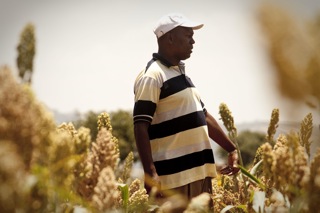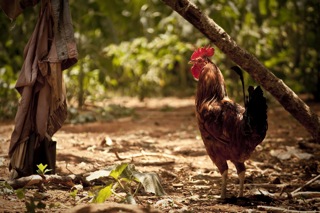Case-study /
Chololo Ecovillage

A model of good practice in climate change adaptation and mitigation
Tanzania Organic Agriculture Movement is part of a team of six agencies working to transform Chololo, near Dodoma, into an ecovillage. The project is supporting and empowering the community to test, evaluate and take up new innovations in agriculture, livestock, water, energy, and forestry.
Since the project started in October 2011, over half of all households have participated in climate change awareness raising events, training workshops, and project activities. With many events taking place at the primary school (800 pupils), including rainwater harvesting and the establishment of a school tree nursery, children are learning about climate change.
Fourteen climate change adaptation interventions have been tested so far, with evaluation underway.
Improved harvests of crops, notably early maturing sorghum, pearl millet, and sunflower are contributing to the food security of hundreds of farming households and increasing household incomes for over 100 farmers, while 123 chicken keepers, mostly female, are starting to see the results of improved breeding and livestock management.
Agriculture
Launched in October 2011, the project had to work very quickly to get farmers prepared for the planting season, which usually starts in December. Due to climate change, rainfall is now less predictable than before. The 2011/12 ‘rainy season’ included a 42-day dry spell that ruined some crops, particularly maize. For this reason, the project focused on agricultural innovations that make the most of the available rainfall.
Some of the actions included:
- Capacity building 400 farmers through intensive training on Good Agricultural Practices: tillage and land preparation, spacing, intercropping, soil water conservation (45 trained), production of quality declared seeds (33 trained);
- Introduction and supply of 24 ox-drawn tillage implements: Magoye ripper, ox-weeder/ridger/plough (80 trained);
Ox-drawn Magoye Ripper breaks up the hard pan, allowing rainwater to enrich the soil
- Introduction and supply of improved seeds (drought-resistant / high-yielding / early-maturing): sorghum (100 farmers), pearl millet (190), cowpeas (122), groundnuts (8), sunflower (112);
- Sub sector selection and analysis to identify income generation activity of most benefit to women (191 farmers involved).
Widespread take up of agricultural innovations has led to very promising results particularly in food security.
- The improved varieties of sorghum, pearl millet, cowpeas, groundnuts and sunflower have delivered good harvests;
- Family food security has improved as grain stores have been filled;
- Incomes have increased; sales of sunflower and sorghum have enabled some farmers to build modern houses.
Good agricultural practices include correct spacing, intercropping, soil water conservation, and seed production.

Early maturing sorghum (Macia variety)

Improved cocks for increased production and incomes
Livestock
Livestock often have a negative impact on natural resources and farming, through overgrazing of common land, compaction of soil, eating crops, and competing for scarce water resources. The project aims to reduce the negative impact on natural resources and develop positive interactions between livestock and arable farming. Oxen are now being used to prepare land for planting, reducing farmers workload. Farmyard manure is now being used to help fertilise the soil. Crop residues can be used to feed livestock.
The project is increasing the genetic potential of livestock in the village, through the introduction of improved breeds of cattle, goats and chickens. This will increase the productivity of the animals, producing more meat, more milk, and more eggs, more quickly.
We are also working to improve the health of the livestock, and ensure they have adequate feed, particularly during the dry season.
Livestock activities so far include:
- Capacity building training on livestock keeping: cattle (26 farmers trained – 6 female), goats (28 farmers trained – 10 female) and chicken (64 farmers trained – 38 female);
- Supply of 30 improved Mpwapwa breed bulls;
- Supply of 60 blended goat bucks;
- Supply of 123 improved cocks;
- Supply of acaracide for tick control, and other veterinary drugs;
- Established five acres of improved pastures and five acres of browse species;
- Established two small-scale tilapia fish ponds.
Water
Water is a big problem. When the project began in October 2011, there was no drinking water supply to the village as the borehole equipment had broken down, so people (mostly women and girls) had to walk for two hours a day to get a bucket of water from the next village. When the rains come, the water soon runs away, creating gullies, and causing soil erosion, while the groundwater aquifer is not being recharged.
The project is tackling these issues through several innovations:
- The village water supply has been restored after repairs to the village borehole equipment;
- The village primary school has been equipped with roof catchment rainwater harvesting equipment, capturing 60,000 litres of water in underground tanks;
- The nearby riverbed fills up with water in the rainy season then runs dry as the water flows away downstream. The project has constructed a sub surface dam to capture thousands of tons of water in the sandy river bed, providing water for domestic use and livestock through the dry season;
- A sand dam is being built to capture rainwater and recharge the groundwater reserves.
Natural resources & energy
Women walk five hours to collect firewood from the forest, as the trees have been cut down for fuel, charcoal and construction. Trees help to stabilize soils, provide shade and protection from the wind. The loss of trees increases soil erosion, wind speed and land degradation.
The project aims to increase access to natural resources through tree planting, agroforestry, and community land use planning and management, while encouraging the use of alternative sources of energy.
The project has:
- Trained 133 community members and village leaders on afforestation, nursery management and tree planting;
- Planted 14,668 tree seedlings (leuceana, acacia polycanth, neem, mango, guava) at 208 households, six churches, the primary school, and the dispensary;
- Planted 3,000 trees in three acres of village forest reserve.
Residents are being supported to take up, test, and evaluate a range of renewable energy technologies, including energy saving cooking stoves, and low cost biogas plants.
Energy-saving stoves can reduce the amount of wood needed to cook, and thereby reduce pressure on forest resources, while saving women time and effort, and reducing harmful smoke in the home.
Biogas digesters convert biomass, particularly animal dung which is readily available and currently little used, into a gas that can fuel cooking stoves and lamps. A bi-product of the biogas digester is a ready-to-use nutrient-rich manure slurry, a natural soil fertiliser.
Villagers have been empowered (literally) with:
- 10 domestic biogas plants producing energy for cooking and lighting;
- 60 energy-saving cooking stoves installed in 60 households, using half as much wood, and evacuating smoke through a chimney;
- The project is studying the feasibility of a hybrid solar panel / wind turbine water pumping system for the village borehole.
Scaling up – sharing the good practice
It is clear that the Ecovillage project is creating a useful model of good practice. The challenge is how to scale up and share these good innovations with other communities across the region who are also facing the impact of climate change.
- Farmers field days help to celebrate and share good practice;
- National TV and press coverage is helping to spread the word;
- Chololo farmers tell the story on local radio, encouraging other farmers to try the innovations;
- A Swahili drama and dance group explains the causes and effects of climate change, and encourages tree-planting, good agricultural practices, rainwater harvesting, and the use of alternative energy;
- The Chololo Ecovillage website is keeping a diary of the project, in words, pictures, sound and video: http://chololoecovillage.wordpress.com/
- Join us on FaceBook: just search for Chololo Ecovillage.
Chololo Ecovillage Project is delivered by a partnership of the following agencies:
- Institute of Rural Development Planning (IRDP) www.irdp.ac.tz
- Agricultural Research Institute Hombolo (ARIH)
- Dodoma Environmental Network (DONET)
- Dodoma Municipal Council (DMC)
- Maji na Maendeleo Dodoma (MAMADO) www.mamado.org
- Tanzania Organic Agriculture Movement (TOAM) www.kilimohai.org
Chololo Ecovillage
This project is funded by the European Union.
A next step in the Chololo Ecovillage project was to conduct a CVCA analysis. Read more here.
